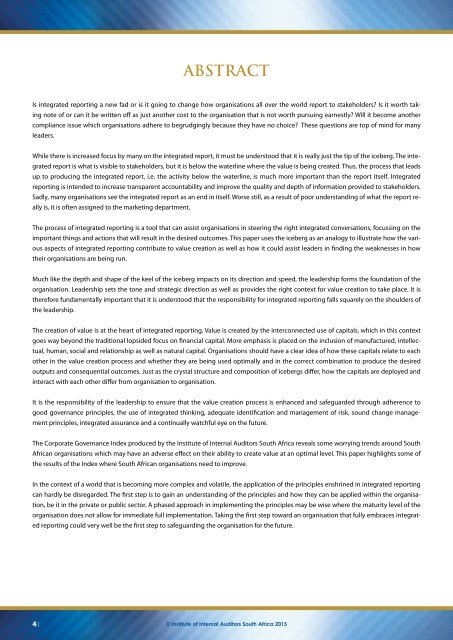INTEGRATED REPORTING TIP OF THE ICEBERG
Integrated_Reporting_Tip_of_the__Iceberg
Integrated_Reporting_Tip_of_the__Iceberg
Create successful ePaper yourself
Turn your PDF publications into a flip-book with our unique Google optimized e-Paper software.
Abstract<br />
Is integrated reporting a new fad or is it going to change how organisations all over the world report to stakeholders? Is it worth taking<br />
note of or can it be written off as just another cost to the organisation that is not worth pursuing earnestly? Will it become another<br />
compliance issue which organisations adhere to begrudgingly because they have no choice? These questions are top of mind for many<br />
leaders.<br />
While there is increased focus by many on the integrated report, it must be understood that it is really just the tip of the iceberg. The integrated<br />
report is what is visible to stakeholders, but it is below the waterline where the value is being created. Thus, the process that leads<br />
up to producing the integrated report, i.e. the activity below the waterline, is much more important than the report itself. Integrated<br />
reporting is intended to increase transparent accountability and improve the quality and depth of information provided to stakeholders.<br />
Sadly, many organisations see the integrated report as an end in itself. Worse still, as a result of poor understanding of what the report really<br />
is, it is often assigned to the marketing department.<br />
The process of integrated reporting is a tool that can assist organisations in steering the right integrated conversations, focussing on the<br />
important things and actions that will result in the desired outcomes. This paper uses the iceberg as an analogy to illustrate how the various<br />
aspects of integrated reporting contribute to value creation as well as how it could assist leaders in finding the weaknesses in how<br />
their organisations are being run.<br />
Much like the depth and shape of the keel of the iceberg impacts on its direction and speed, the leadership forms the foundation of the<br />
organisation. Leadership sets the tone and strategic direction as well as provides the right context for value creation to take place. It is<br />
therefore fundamentally important that it is understood that the responsibility for integrated reporting falls squarely on the shoulders of<br />
the leadership.<br />
The creation of value is at the heart of integrated reporting. Value is created by the interconnected use of capitals, which in this context<br />
goes way beyond the traditional lopsided focus on financial capital. More emphasis is placed on the inclusion of manufactured, intellectual,<br />
human, social and relationship as well as natural capital. Organisations should have a clear idea of how these capitals relate to each<br />
other in the value creation process and whether they are being used optimally and in the correct combination to produce the desired<br />
outputs and consequential outcomes. Just as the crystal structure and composition of icebergs differ, how the capitals are deployed and<br />
interact with each other differ from organisation to organisation.<br />
It is the responsibility of the leadership to ensure that the value creation process is enhanced and safeguarded through adherence to<br />
good governance principles, the use of integrated thinking, adequate identification and management of risk, sound change management<br />
principles, integrated assurance and a continually watchful eye on the future.<br />
The Corporate Governance Index produced by the Institute of Internal Auditors South Africa reveals some worrying trends around South<br />
African organisations which may have an adverse effect on their ability to create value at an optimal level. This paper highlights some of<br />
the results of the Index where South African organisations need to improve.<br />
In the context of a world that is becoming more complex and volatile, the application of the principles enshrined in integrated reporting<br />
can hardly be disregarded. The first step is to gain an understanding of the principles and how they can be applied within the organisation,<br />
be it in the private or public sector. A phased approach in implementing the principles may be wise where the maturity level of the<br />
organisation does not allow for immediate full implementation. Taking the first step toward an organisation that fully embraces integrated<br />
reporting could very well be the first step to safeguarding the organisation for the future.<br />
4 | © Institute of Internal Auditors South Africa 2015



